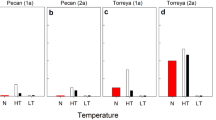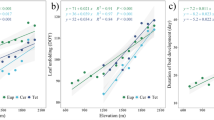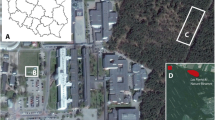Abstract
While the high elevation limit of trees is commonly related to low temperature, the rear edge of their distribution is often associated with drought. Here we explore phenology traits that contribute to a mechanistic explanation of both these edges of the fundamental niche in the broad leaved evergreen Quercus pannosa s.l. Populations of this species reach a drought limit (DL) at 2510 m in the semi-arid upper Yangtze valley, and a cold limit (CL) at 4270 m, very close to the conifer treeline, within a short geographical distance. Trees reach a height of only 4–7 m at both climatic limits, and > 30 m height at optimum site (OS) at 3440 m. At OS, flushing starts in mid-May and at the summer solstice at CL (after late frosts end), suggesting a photoperiod control. At DL, oak phenology tracks the (irregular) arrival of the monsoon. Shoots and leaves grew fastest and for the shortest period at DL, and slowest at CL, in both cases forming 4–7 cm long new shoots per year, contrasted by 12–13 cm a−1 at OS. Maturation of leaves (length and specific leaf area, SLA) was again fastest at DL, followed by CL and slowest at OS, with a much longer shoot growth duration per year and bigger leaves. We conclude that the period favorable for growth and maturation was more than halved at both range limits (by frost or drought) compared to the optimum site, pointing at a common range restriction by the duration of the growing season.






Similar content being viewed by others
Change history
15 April 2021
A Correction to this paper has been published: https://doi.org/10.1007/s00035-021-00253-y
References
Alberto F, Bouffier L, Louvet JM, Lamy JB, Delzon S, Kremer A (2011) Adaptive responses for seed and leaf phenology in natural populations of sessile oak along an altitudinal gradient. J Evol Biol 24:1442–1454. https://doi.org/10.1111/j.1420-9101.2011.02277.x
Basler D, Körner C (2012) Photoperiod sensitivity of bud burst in 14 temperate forest tree species. Agric For Meteorol 165:73–81. https://doi.org/10.1016/j.agrformet.2012.06.001
Basler D, Körner C (2014) Photoperiod and temperature responses of bud swelling and bud burst in four temperate forest tree species. Tree Physiol 34:377–388. https://doi.org/10.1093/treephys/tpu021
Bennie J, Kubin E, Wiltshire A et al (2010) Predicting spatial and temporal patterns of bud-burst and spring frost risk in north-west Europe: the implications of local adaptation to climate. Glob Change Biol 16:1503–1514. https://doi.org/10.1111/j.1365-2486.2009.02095.x
Chuine I, Beaubien EG (2001) Phenology is a major determinant of tree species range. Ecol Lett 4:500–510. https://doi.org/10.1046/j.1461-0248.2001.00261.x
Costa-e-Silva F, Correia AC, Piayda A et al (2015) Effects of an extremely dry winter on net ecosystem carbon exchange and tree phenology at a cork oak woodland. Agric For Meteorol 204:48–57. https://doi.org/10.1016/j.agrformet.2015.01.017
Dantec CF, Ducasse H, Capdevielle X et al (2015) Escape of spring frost and disease through phenological variations in oak populations along elevation gradients. J Ecol 103:1044–1056. https://doi.org/10.1111/1365-2745.12403
Davis SD, Mooney HA (1986) Tissue water relations of four co-occurring chaparral shrubs. Oecologia 70:527–535. https://doi.org/10.1007/BF00379899
Denk T, Grimm GW (2010) The oaks of western Eurasia: traditional classifications and evidence from two nuclear markers. Taxon 59:351–366. https://doi.org/10.1002/tax.592002
Ducousso A, Guyon JP, Kremer A (1996) Latitudinal and altitudinal variation of bud burst in western populations of sessile oak (Quercus petraea (Matt) Liebl). Ann For Sci 53:775–782. https://doi.org/10.1051/forest:19960253
FAO (1978–1981) Reports of the agro-ecological zones project. World Soil Resources Report 48 vol 1: Methodology and results for Africa; vol. 2: South‐west Asia; vol. 3: South and Central America; vol. 4: South‐east Asia. Food and Agriculture Organization of the United Nations, Rome
Fenner M (1998) The phenology of growth and reproduction in plants. Perspect Plant Ecol Evol Syst 1:78–91. https://doi.org/10.1078/1433-8319-00053
García-Mozo H, Mestre A, Galán C (2010) Phenological trends in southern Spain: a response to climate change. Agric For Meteorol 150:575–580. https://doi.org/10.1016/j.agrformet.2010.01.023
Gerst KL, Rossington NL, Mazer SJ (2017) Phenological responsiveness to climate differs among four species of Quercus in North America. J Ecol 105:1610–1622. https://doi.org/10.1111/1365-2745.12774
Gordo O, Sanz J (2010) Impact of climate change on plant phenology in Mediterranean ecosystems. Glob Change Biol 16:1082–1106. https://doi.org/10.1111/j.1365-2486.2009.02084.x
He XF, Wang SW, Sun H et al (2020) Water relations of ‘trailing-edge’ evergreen oaks in the semiarid upper Yangtze region, SE Himalaya. J Syst Evol. https://doi.org/10.1111/jse.12696
Hipp AL (2015) Should hybridization make us skeptical of the oak phylogeny. Int Oaks 26:9–18
Joshi R, Sambhav K, Singh SP (2018) Near surface temperature lapse rate for treeline environment in western himalaya and possible impacts on ecotone vegetation. Trop Ecol 59:197–209
Kikuzawa K (1995) The basis for variation in leaf longevity of plants. Vegetation 121:89–100. https://doi.org/10.1007/BF00044675
Körner C (2006) Significance of temperature in plant life. In: Morison JIL, Morecroft MD (eds) Plant growth and climate change. Blackwell Publishing, Oxford, pp 48–69. https://doi.org/https://doi.org/10.1002/9780470988695.ch3
Körner C (2008) Winter crop growth at low temperature may hold the answer for alpine treeline formation. Plant Ecol Divers 1:3–11. https://doi.org/10.1080/17550870802273411
Körner C (2012) Alpine treelines: functional ecology of the global high elevation tree limits. Springer, Basel
Körner C (2013) Plant-environment interactions. In: Bresinsky A (ed) Strasburger’s plant sciences. Springer, Berlin
Körner C (2015) Paradigm shift in plant growth control. Curr Opin Plant Biol 25:107–114. https://doi.org/10.1016/j.pbi.2015.05.003
Körner C, Basler D (2010) Phenology under global warming. Science 327:1461–1462
Körner C, Basler D, Hoch G et al (2016) Where, why and how? Explaining the low-temperature range limits of temperate tree species. J Ecol 104:1076–1088. https://doi.org/10.1111/1365-2745.12574
Kremer A, Abbott AG, Carlson JE et al (2012) Genomics of Fagaceae. Tree Genet Genom 8:583–610. https://doi.org/10.1007/s11295-012-0498-3
Kuster TM, Dobbertin M, Günthardt-Goerg MS et al (2014) A phenological timetable of oak growth under experimental drought and air warming. PLoS ONE 9:e89724. https://doi.org/10.1371/journal.pone.0089724
Lempereur M, Limousin J-M, Guibal F et al (2017) Recent climate hiatus revealed dual control by temperature and drought on the stem growth of Mediterranean Quercus ilex. Glob Change Biol 23:42–55. https://doi.org/10.1111/gcb.13495
Lenz A, Hoch G, Vitasse Y et al (2013) European deciduous trees exhibit similar safety margins against damage by spring freeze events along elevational gradients. New Phytol 200:1166–1175. https://doi.org/10.1111/nph.12452
Liepe K (1993) Growth-chamber trial on frost hardiness and field trial on flushing of sessile oak (Quercus petraea Liebl). Ann For Sci 50:208–214. https://doi.org/10.1051/forest:19930719
Lobo-do-Vale R, Besson C, Caldeira M et al (2019) Drought reduces tree growing season length but increases nitrogen resorption efficiency in a Mediterranean ecosystem. Biogeosciences 16:1265–1279
Misson L, Degueldre D, Collin C et al (2011) Phenological responses to extreme droughts in a Mediterranean forest. Glob Change Biol 17:1036–1048. https://doi.org/10.1111/j.1365-2486.2010.02348.x
Montserrat-Martí G, Camarero JJ, Palacio S et al (2009) Summer-drought constrains the phenology and growth of two coexisting Mediterranean oaks with contrasting leaf habit: implications for their persistence and reproduction. Trees 23:787–799. https://doi.org/10.1007/s00468-009-0320-5
Morin X, Augspurger C, Chuine I (2007) Process-based modeling of species’ distributions: what limits temperate tree species’ range boundaries? Ecology 88:2280–2291
Muller B, Pantin F, Génard M et al (2011) Water deficits uncouple growth from photosynthesis, increase C content, and modify the relationships between C and growth in sink organs. J Exp Bot 62:1715–1729. https://doi.org/10.1093/jxb/erq438
Niinemets Ü (2010) Responses of forest trees to single and multiple environmental stresses from seedlings to mature plants: Past stress history, stress interactions, tolerance and acclimation. For Ecol Manage 260:1623–1639. https://doi.org/10.1016/j.foreco.2010.07.054
Nitta I, Ohsawa M (1997) Leaf dynamics and shoot phenology of eleven warm-temperate evergreen broad-leaved trees near their northern limit in central Japan. Plant Ecol 130:71–88. https://doi.org/10.1023/a:1009735709258
Ogaya R, Penuelas J (2006) Contrasting foliar responses to drought in Quercus ilex and Phillyrea latifolia. Biol Plant 50:373–382. https://doi.org/10.1007/s10535-006-0052-y
Paulsen J, Körner C (2014) A climate-based model to predict potential treeline position around the globe. Alp Bot 124:1–12. https://doi.org/10.1007/s00035-014-0124-0
Peñuelas J, Filella I, Stefanescu C et al (2004) Plant and animal phenological changes linked to recent and predicted climate change in Catalonia (North western Mediterranean basin). Challeng Times:59
Peñuelas J, Hunt JM, Ogaya R et al (2008) Twentieth century changes of tree-ring δ13C at the southern range-edge of Fagus sylvatica: increasing water-use efficiency does not avoid the growth decline induced by warming at low altitudes. Glob Change Biol 14:1076–1088. https://doi.org/10.1111/j.1365-2486.2008.01563.x
Pinheiro J, Bates D, DebRoy S, Sarkar D, R Core Team (2020) Nlme: linear and nonlinear mixed effects models. R package version 3.1–149. https://CRAN.R-project.org/package=nlme
Pinto CA, Henriques MO, Figueiredo JP et al (2011) Phenology and growth dynamics in Mediterranean evergreen oaks: effects of environmental conditions and water relations. For Ecol Manage 262:500–508. https://doi.org/10.1016/j.foreco.2011.04.018
Russell VL (2016) Least-squares means: the R package lsmeans. J Stat Softw 69:1–33. https://doi.org/10.18637/jss.v069.i01
Sampaio T, Branco M, Guichoux E et al (2016) Does the geography of cork oak origin influence budburst and leaf pest damage? For Ecol Manage 373:33–43. https://doi.org/10.1016/j.foreco.2016.04.019
Samtani JB, Appleby JE, Masiunas JB (2015) Comparative leaf phenology of white oak and northern red oak. Horticulturae 1:44–54
Sarris D, Christodoulakis D, Körner C (2007) Recent decline in precipitation and tree growth in the eastern Mediterranean. Glob Change Biol 13:1187–1200. https://doi.org/10.1111/j.1365-2486.2007.01348.x
Singh P, Negi G (2018) Treeline species phenology: shoot growth, leaf characteristics and nutrient dynamics. Trop Ecol 59:297–311
Spiess N, Oufir M, Matušíková I et al (2012) Ecophysiological and transcriptomic responses of oak (Quercus robur) to long-term drought exposure and rewatering. Environ Exp Bot 77:117–126. https://doi.org/10.1016/j.envexpbot.2011.11.010
Vitasse Y, Delzon S, Bresson CC et al (2009) Altitudinal differentiation in growth and phenology among populations of temperate-zone tree species growing in a common garden. Can J For Res 39:1259–1269. https://doi.org/10.1139/X09-054
Vitasse Y, Bresson CC, Kremer A et al (2010) Quantifying phenological plasticity to temperature in two temperate tree species. Funct Ecol 24:1211–1218. https://doi.org/10.1111/j.1365-2435.2010.01748.x
Way DA, Montgomery RA (2015) Photoperiod constraints on tree phenology, performance and migration in a warming world. Plant Cell Environ 38:1725–1736. https://doi.org/10.1111/pce.12431
Yang Y, Sun H, Körner C (2020) Explaining the exceptional 4,270 m high elevation limit of an evergreen oak in the south-eastern Himalaya. Tree Physiol. https://doi.org/10.1093/treephys/tpaa070
Zhang SB, Zhou ZK, Hu H et al (2007) Gas exchange and resource utilization in two alpine oaks at different altitudes in the Hengduan Mountains. Can J For Res 37:1184–1193. https://doi.org/10.1139/x06-303
Zhou ZK, Pu CX, Chen WY (2003) Relationships between the distributions of Quercus sect Heterobalanus (Fagaceae) and uplift of Himalayas. Adv Earth Sci 18:884–890
Acknowledgements
We would like to thank Deqen Meteorological station for sharing their data.
Funding
This work was supported by the National Key R and D Program of China (2017YFC0505200 to H. S.), NSFC-Yunnan joint fund to support key projects (U1802232 to H. S.) equally, the Second Tibetan Plateau Scientific Expedition and Research program (2019QZKK0502 to H. S.), Young Academic and Technical Leader Raising Foundation of Yunnan Province (2018HB065 to Y. Y.), the Ten-thousand Talents Program of Yunnan Province (YNWR-QNBJ-2018-318 to Y. Y.) and the Yunnan Applied Basic Research Project (2018FA015 to Y. Y.).
Author information
Authors and Affiliations
Contributions
CK conceived and designed the work. WSW, HXF, CJG, and YY jointly performed the fieldwork. WSW, YY and CK jointly performed data analysis and manuscript writing. HS facilitated the project by logistic and infrastructure support and contributed to the text.
Corresponding authors
Ethics declarations
Conflict of interest
The authors declare that they have no conflict of interest.
Ethical approval
This study does not involve research on human participants or animals.
Informed consent
Informed consent was obtained from all individual participants included in the study.
Additional information
Publisher's Note
Springer Nature remains neutral with regard to jurisdictional claims in published maps and institutional affiliations.
The original version of this article was revised due to an error in Funding Number.
Supplementary Information
Below is the link to the electronic supplementary material.
Rights and permissions
About this article
Cite this article
Wang, SW., He, XF., Chen, JG. et al. Elevation-specific responses of phenology in evergreen oaks from their low-dry to their extreme high-cold range limits in the SE Himalaya. Alp Botany 131, 89–102 (2021). https://doi.org/10.1007/s00035-020-00245-4
Received:
Accepted:
Published:
Issue Date:
DOI: https://doi.org/10.1007/s00035-020-00245-4




